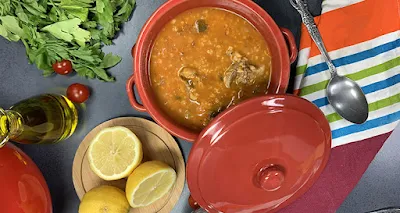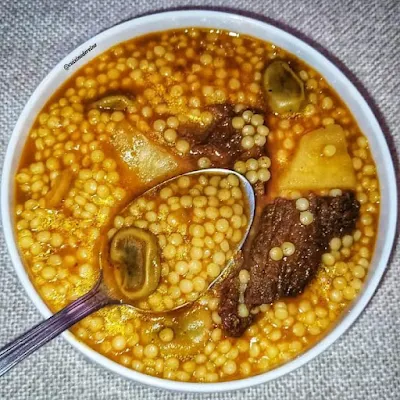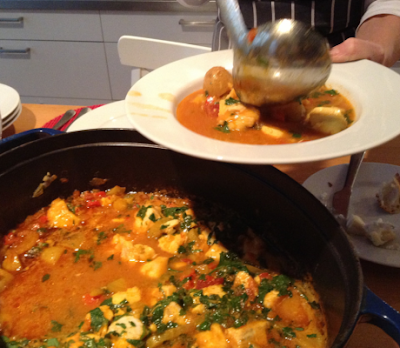Most popular Tunisian dishes 2
Soup
1. Lablabi (شربة الفول)
Origin: Tunisia.
Description: A warming chickpea soup seasoned with cumin and harissa, often eaten for breakfast.
Servings: 4
Ingredients:
- 300g chickpeas (soaked overnight)
- 1 liter of water
- 2 cloves of garlic
- 2 tablespoons of harissa
- 200g stale bread
- Olive oil and spices.
- Cook chickpeas in water until soft.
- Blend garlic and harissa, then add to the pot.
- Tear bread into pieces and serve in bowls, topped with soup.
Eating Method: Eaten with a spoon.
When to Eat: Commonly enjoyed for breakfast or lunch.
Famous Places: El-Wahy (Tunis), local street vendors.
Average Price: 4-6 TND (~1.33-2 USD).
2. Chorba Frik (Freekeh Soup)
Origin: This hearty soup dates back to the Ottoman era and remains a favorite in Tunisian cuisine, especially during Ramadan.
Ingredients:
- 100g freekeh (cracked green wheat)
- 200g lamb or chicken pieces
- 1 large onion, chopped
- 2 garlic cloves, minced
- 2 tablespoons olive oil
- 3 tomatoes, diced
- 1 tablespoon tomato paste
- 1 teaspoon cumin
- 1 teaspoon coriander powder
- 1 teaspoon paprika
- Salt and pepper to taste
- 4 cups water or broth
- Fresh parsley for garnish
Preparation:
- Heat olive oil in a pot, add onions and garlic, and sauté until golden.
- Add meat, tomatoes, tomato paste, cumin, coriander, paprika, salt, and pepper. Sauté for 5 minutes.
- Add freekeh and water or broth, simmer for 45-60 minutes until meat and freekeh are tender.
Serving: Served hot, often garnished with fresh coriander.
Best Time to Eat: Commonly enjoyed during Ramadan as a starter.
Regions Famous For: Widespread across Tunisia.
Average Price: 5-7 TND ($2-3).
3. Mhammes
Origin: This North African dish, similar to couscous, uses pearl-sized pasta and is a comforting meal during the winter.
Ingredients:
- 500g mhammes pasta
- 200g lamb or chicken
- Vegetables (potatoes, carrots)
- Spices: coriander, salt, pepper
Preparation:
- Simmer meat with vegetables and spices until tender.
- Steam the mhammes, then combine with the broth.
Serving: Served warm in a bowl with vegetables and broth.
Best Time to Eat: A common winter dish, often for lunch.
Regions Famous For: Central and southern Tunisia.
Average Price: 6-9 TND ($2-3).
4. Chorba Homs (Chickpea Soup)
Description: A creamy chickpea soup seasoned with cumin and coriander, sometimes served with lamb.Origin: Common across North Africa and the Mediterranean.
Servings: Serves 4.
Ingredients:
- 1 cup dried chickpeas (soaked overnight)
- 1 large onion, chopped
- 2 garlic cloves, minced
- 2 tablespoons olive oil
- 3 tomatoes, diced
- 1 teaspoon cumin
- 1 teaspoon coriander powder
- Salt and pepper to taste
- 4 cups water or broth
- Fresh coriander for garnish
- Boil chickpeas until tender, then drain.
- In a pot, heat olive oil, add onions and garlic, sauté until translucent.
- Add tomatoes, chickpeas, cumin, coriander, salt, and pepper. Pour in water or broth, simmer for 30 minutes.
Best Time to Eat: Winter and Ramadan.
Regions Famous For: Central Tunisia.
Average Price: $1.5-3 (4-8 TND).
5. Chorba Adas (Lentil Soup)
Description: A nutritious soup made from lentils, seasoned with cumin and turmeric.Origin: Common across North Africa, a winter favorite.
Servings: Serves 4-6.
Ingredients:
Best Time to Eat: Winter and fall.
Regions Famous For: Throughout Tunisia.
Average Price: $1-2.5 (3-7 TND).
Description: A thick, hearty soup made with bulgur and spices, often paired with lamb or chicken.
Origin: Middle Eastern influence in Tunisian cuisine.
Servings: Serves 4.
Ingredients:
Best Time to Eat: Fall and winter.
Regions Famous For: Inland regions.
Average Price: $2-4 (5-10 TND).
7. Chorba Samak (Fish Soup)
Description: A tomato-based fish soup with a hint of lemon, popular in coastal areas.
Origin: Coastal Tunisia.
Servings: Serves 4.
Ingredients:
Best Time to Eat: Year-round.
Regions Famous For: Sfax and coastal areas.
Average Price: $3-5 (8-15 TND).
Origin: Common in rural Tunisia.
Servings: Serves 4.
Ingredients:
Best Time to Eat: Winter.
Regions Famous For: Inland regions.
Origin: Common in Mediterranean diets.
Servings: Serves 4-6.
Ingredients:
Best Time to Eat: Winter.
Regions Famous For: Throughout Tunisia.
Average Price: $2-4 (5-10 TND).
Harira
- 1 cup dried lentils, rinsed
- 1 large onion, chopped
- 2 garlic cloves, minced
- 2 tablespoons olive oil
- 3 tomatoes, diced
- 1 teaspoon cumin
- 1 teaspoon turmeric
- Salt and pepper to taste
- 4 cups water or broth
- 1 lemon, sliced
- Heat olive oil in a pot, sauté onions and garlic.
- Add tomatoes, lentils, cumin, turmeric, salt, and pepper, then add water.
- Simmer for 30-40 minutes until lentils are tender. Squeeze lemon juice before serving
Best Time to Eat: Winter and fall.
Regions Famous For: Throughout Tunisia.
Average Price: $1-2.5 (3-7 TND).
6. Chorba Borghol (Bulgur Soup)
 |
| Chorba Borghol |
Description: A thick, hearty soup made with bulgur and spices, often paired with lamb or chicken.
Origin: Middle Eastern influence in Tunisian cuisine.
Servings: Serves 4.
Ingredients:
- 1 cup bulgur
- 200g lamb or chicken, cubed
- 1 large onion, chopped
- 2 garlic cloves, minced
- 2 tablespoons olive oil
- 3 tomatoes, diced
- Salt and pepper to taste
- 4 cups water or broth
- Fresh parsley for garnish
- Sauté onions, garlic, and meat in olive oil until browned.
- Add tomatoes, bulgur, salt, pepper, and water.
- Simmer for 40-50 minutes until bulgur is soft.
Best Time to Eat: Fall and winter.
Regions Famous For: Inland regions.
Average Price: $2-4 (5-10 TND).
7. Chorba Samak (Fish Soup)
Description: A tomato-based fish soup with a hint of lemon, popular in coastal areas.Origin: Coastal Tunisia.
Servings: Serves 4.
Ingredients:
- 200g white fish fillets
- 1 large onion, chopped
- 2 garlic cloves, minced
- 2 tablespoons olive oil
- 3 tomatoes, diced
- 1 celery stalk, chopped
- Salt and pepper to taste
- 4 cups water or fish broth
- Juice of 1 lemon
- Fresh parsley for garnish
- Sauté onions, garlic, and celery in olive oil.
- Add tomatoes, fish, water, salt, pepper, and simmer for 20 minutes.
- Add lemon juice before serving.
Best Time to Eat: Year-round.
Regions Famous For: Sfax and coastal areas.
Average Price: $3-5 (8-15 TND).
8. Chorba Chaair (Barley Soup)
Description: A thick, filling soup made with barley and seasoned with cumin and coriander.Origin: Common in rural Tunisia.
Servings: Serves 4.
Ingredients:
- 1 cup barley
- 200g lamb or chicken, cubed
- 1 large onion, chopped
- 2 garlic cloves, minced
- 2 tablespoons olive oil
- 3 tomatoes, diced
- Salt and pepper to taste
- 4 cups water or broth
- Fresh parsley for garnish
- Sauté onions, garlic, and meat in olive oil until browned.
- Add tomatoes, barley, water, salt, and pepper.
- Simmer for 45 minutes until barley is tender.
Best Time to Eat: Winter.
Regions Famous For: Inland regions.
Average Price: $2-4 (5-10 TND).10.
9. Chorba Sbanikh (Spinach Soup)
Description: A nutritious soup with spinach and tomatoes, sometimes with meat.Origin: Common in Mediterranean diets.
Servings: Serves 4-6.
Ingredients:
- 2 cups fresh spinach leaves, chopped
- 1 large onion, chopped
- 2 garlic cloves, minced
- 2 tablespoons olive oil
- 3 tomatoes, diced
- Salt and pepper to taste
- 4 cups water or broth
- Juice of 1 lemon
- Sauté onions and garlic in olive oil.
- Add tomatoes, spinach, salt, and pepper. Pour in water.
- Simmer for 20 minutes until spinach is wilted.
- Add lemon juice before serving.
Best Time to Eat: Winter.
Regions Famous For: Throughout Tunisia.
Average Price: $2-4 (5-10 TND).
Harira
- Description: A rich, comforting soup traditionally enjoyed during Ramadan.
- Ingredients:
- 200g meat (lamb or chicken)
- 100g lentils
- 100g chickpeas
- 2 chopped tomatoes
- 1 chopped onion
- Spices (coriander, cumin, pepper)
- Preparation:
- Boil meat with onions and spices.
- Add lentils and chickpeas and let simmer.
- Add tomatoes and cook for an additional 15 minutes.
- Presentation: Served hot with a slice of bread.
- When enjoyed: Primarily during Ramadan.
- Famous Locations: A staple in most households.
- Where to Buy: Some restaurants serve it during Ramadan.
- Average Price: 4-8 Tunisian Dinars.
Each of these soups highlights Tunisia’s rich culinary traditions, seasonal ingredients, and regional flavors, providing a satisfying culinary experience for any time of year.










No comments